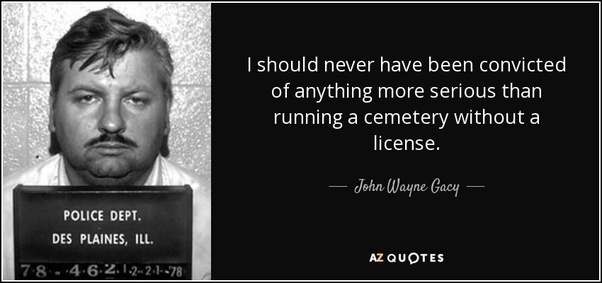You would be surprised how many serial killers are mistaken as ordinary people, how they seemed to be charming, and fun, and interesting, and even helpful and sweet, all the while a horrible monster is lurking just underneath the surface. Misinterpretation of body language, social norms, and emotions often lead to terrible situations where a secret psychopath is concerned. I am finishing up my psychology degree, with a criminal justice bachelor’s under my belt, and I have always found it fascinating how well some serial killers hide their true natures, so lets get into it!

Many serial killers are psychopaths, but what does that mean exactly? What is psychopathy? Well, here are some basics; psychopathy is usually used to describe someone who has anti social personality disorder, or ASPD. Psychopathy is not actually a diagnosis if we are getting technical here. ASPD means in simple terms, someone who manipulates others through tactics that form patterns, and violate others to great extents. A person with ASPD goes against social norms, rules, and behaviors that are “normal”. These people have little to no empathy towards others, often cause pain or harm to animals or people, have an inability to distinguish between right and wrong, manipulate others to get what they want, disregard safety and responsibility, lie constantly, are arrogant and cruel, and go against everything that is generally thought of as “normal”. These people can also be very intelligent, very charming, and draw people to themselves. Some famous serial killers who would fall under the general scope of Psychopathy include; Ted Bundy, Jeffrey Dahmer, Ed Gein, John Gacy, and Aileen Wuornos to name a few. Psychopathy is rare, however the rates are roughly one out of every hundred people is a psychopath. Not all psychopaths are dangerous serial killers however, many are just ordinary every day people who are going about their lives with a different mind set to everyone else. Unless a psychopath kills someone, you might never even know they are there.

What makes a serial killer able to hide his true nature from those around him? How does the killers family, friends, and work place peers not notice the signs? Are there any to be seen? Were they just not looking closely enough? How does someone miss a wolf in sheep’s clothing? Some victims of rape, violence, attempted murder, or murder are initiated through conversation, and the victims that survive to tell the tale report that often they misinterpreted the attacker’s intentions, emotions, and motivations based on standard social rules and common expressions. They often report that the attackers were smiling, or seemed polite, nice, and interested in what the victim was doing. That sometimes the attacker told them they needed help or were lost, or just wanted to chat. These are all just a ruse, and the attacker’s true intentions only became known once it was too late. Many famous murderers would fool their victims and lull them into a false sense of security before harming them. Misinterpretation can prove deadly. How can you spot a serial killer? Well, according to criminologists, there are five major traits to watch out for…

HOW TO SPOT A SERIAL KILLER 101
Usually They are a Power Junkie
‘Serial killers typically have a real affinity with power, even when they’ve been caught and know the game is
up,’ explained the experts. To read the full article, you can click the link at the bottom of the post, but it mainly states that Serial Killers want to be in control at all times, they are control freaks and want to have prestige and recognition for the things they do.

They Like to Manipulate People
Gaslighting and manipulation are key elements to serial killers.
‘Apparent vulnerability and the need to please have been used effectively time and time
again by serial killers as a way of hiding a sinister personality,’ continued the experts.
‘Some of the world’s best known serial killers have a frightening ability to manipulate
those around them, pressing the right buttons in order to present themselves in a false
light.’ Chilling right? Know anyone like that in your social circle? Makes you think doesn’t it?

They Are Egotistical Braggers
Real Crime and Dr Yardley said: ‘Egoistical serial killers often can’t help but brag about the
atrocities they’ve committed, whether it’s aimed at their accomplices, the next victim, law enforcement, or just
themselves.” So in other words, they want everyone to know how awesome they are at killing. How amazing their techniques are, and how many people they killed. This can translate to real life for many serial killers that haven’t been found out yet. Frequent things a serial killer might come up with in order to make themselves seem more important would include fictional stories where they are the savior of the situation, fictional jobs where they are essential, elevating themselves in any given scenario, or bragging about how awesome they are in general is common place serial killers. Most of them are inherent narcissists.

Many are Superficially Charming
’Serial killers tend to have a very good grasp of other people’s emotions and are quick to pick up on any
vulnerability or weakness in order to convince them into doing things they normally wouldn’t,’ added Dr
Yardley.
‘They’ll get others on side and take charge of a situation with a mix of
compliments and common sense.’
Hell, John Gacy was often invited to play as a clown at children’s birthday parties… Enough said!

Most Seem Like Just an Average Guy
Meanwhile, Real Crime continued: ‘Possibly the scariest trait of all, many serial killers look like a pillar of the
community on first sight.”
Yea… Just the helpful neighbor, the guy at church, the gas station attendant, the clown at your child’s six year birthday party… Who knows which one of them is actually a serial killer? Do you really know anyone?

Misinterpretation of someone else’s emotions can affect your motivation to either continue or discontinue a conversation (or even a relationship) very easily. Miscommunication and misinterpretation can be very dangerous or very harmless. For instance, if you think someone likes you and you misinterpret basic polite conversation for actual attraction, like, or interest, you might continue the conversation long after what would be normally appropriate. Humans are also inclined to like or trust someone who is attractive or charming, its just the way we are, for instance, check out the couple pictured above, looks like a pair you would invite to hang out with you at a club or something right? Well, if you did invite them out, you might not survive the night… The man, Bernardo was convicted of first-degree murder in the deaths of two teen girls, Leslie Mahaffy, and Kristen French. He later admitted to raping 14 other women and helping kill his wife’s 15-year-old sister, Tammy Homolka. During the “trial of the century” for Canada, Bernardo was sentenced to life imprisonment and later declared a dangerous offender. The woman pictured next to him is still free, out on a plea deal despite her roles in the murders… Karla Homolka is probably up for a good time if you ever happen to be in Canada…

In the end, people can only try their best to read body language and social cues in order to try to understand the people around them. Conversations can go south very quickly if a social cue is missed and emotions are misinterpreted or missed altogether. A polite conversation can be mistaken for instant attraction, a confused frown could result in the other person thinking the listener is angry or uninterested in the conversation. Trying to navigate another person’s feelings is difficult and hard to do, but in the end, we all seem to manage it to some extent. It is usually a harmless thing to misinterpret someone’s emotions, motives, and true intentions, but it can also be deadly if you are talking with the wrong person…
To read up on more serial killer spotting facts check out this article!




